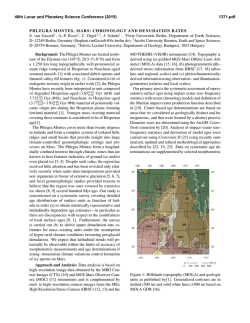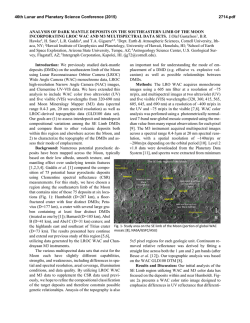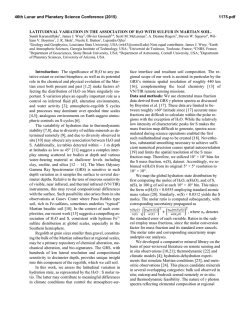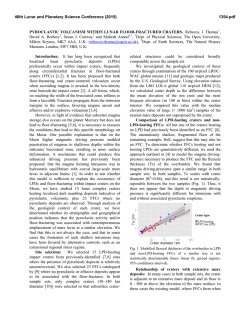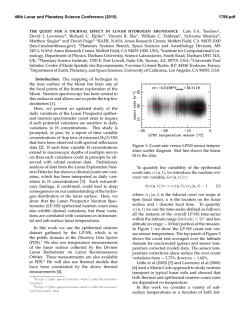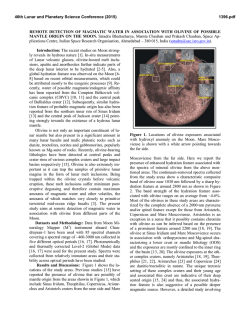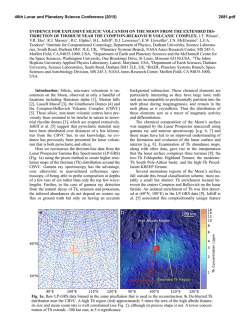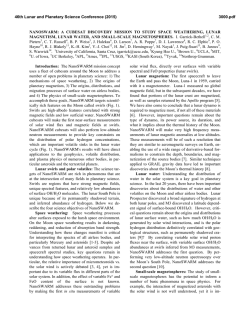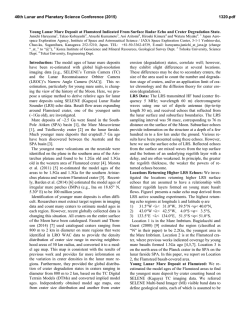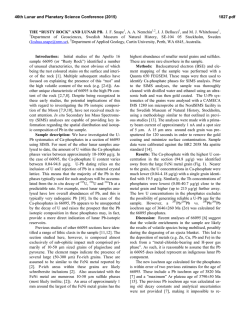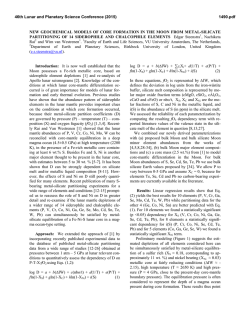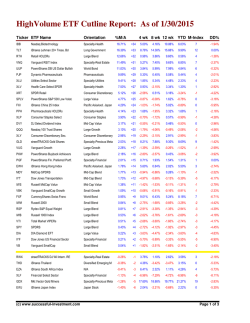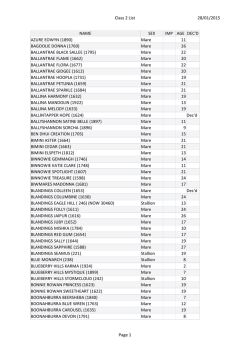
1908
46th Lunar and Planetary Science Conference (2015) 1908.pdf INVESTIGATION OF SINUS AESTUUM, RIMA BODE, AND VAPORUM REGIONAL DARK MANTLE DEPOSITS. C. M. Weitz1, M. Staid1, L. Gaddis2, and S. Besse3, 1Planetary Science Institute, 1700 E Fort Lowell, Suite 106, Tucson, AZ 85719 ([email protected]); 2Astrogeology Science Center, U. S. Geological Survey, 2255 N. Gemini Drive, Flagstaff, AZ 86001; 3ESA/ESTEC SRE-S Keplerlaan 1, 2201 AZ Noordwijk, The Netherlands. Introduction: Lunar dark mantle deposits (DMDs) were produced in explosive volcanic eruptions and are identified based upon their relatively low albedos, surface smoothness, mantling relationship to underlying terrain, and spectral absorption bands due to the presence of iron-bearing volcanic glasses [1-6]. DMDs may be composed of glasses and/or crystallized beads, with glasses exhibiting a broad absorption centered near 1 µm and generally displaying weaker absorptions near 2 µm. They can be spectrally differentiated from olivine based on a more symmetrical absorption extending beyond 1 µm [7]. Additionally, the distance between the 1 and 2 µm band minima is shorter for the glasses than in pyroxenes or olivine [8-10]. M3 85-band reflectance measurements provide an excellent data set to characterize the mineralogy of DMDs relative to surrounding materials and interpret their geologic context because the DMDs are readily visible due to their low albedo and broad ferrous absorption relative to surrounding deposits, especially feldspathic materials. Using M3 data [11-13], we produced mineralogic parameter images [8] at three locations: Sinus Aestuum (SA), Rima Bode (RB), and Vaporum (VP). Additional data sets that we utilized include: Lunar Reconnaissance Orbiter (LRO) Narrow Angle Cameras (NAC) and LRO Wide Angle Camera (WAC) [14]; Terrain Camera (TC) and Multispectral Imager (MI) data from the Japanese Space Agency’s (JAXA) SELENE (also called ‘Kaguya’) mission [15]. Using all these data sets, we mapped the distribution of DMDs, explored their stratigraphic relationships to other units, and searched for plausible vents that may have erupted the pyroclastic deposits. Observations: Figure 1 shows a M3 mineralogic parameter mosaic across SA (SA1 and SA2) and RB. Basalts appear pink due to a strong 1 µm absorption, brighter feldspathic areas are lavender (high 1.58 µm reflectance), and pyroclastic glasses appear green due to a shorter wavelength 2 µm band. The spinel-rich areas [16-18] are identified by a strong 2 µm absorption observed in the spectra and appear black. Stratigraphic relationships suggest the following: emplacement of older pyroclastics associated with the spinels (SA1&2) as well as without spinel (RB), followed by mare basalts, then additional eruption(s) of pyroclastics lacking spinels at SA, and finally later feldspathic mixing within the DMDs. The spinel-rich regions in SA are usually best exposed on highland/basin materials rather than with pyroclastic mate- rials now observed at the surface. In general, the pyroclastics are older relative to the mare, but there are a few areas where pyroclastics not associated with spinel appear younger than some of the basalts (Fig. 1). Similar analyses for VP (Fig. 2) also provide insight into the distribution and stratigraphy of the DMD in that region. The distribution of pyroclastics was mapped using M3 spectral information and also Kaguya and WAC images. The DMD is concentrated along highlands and has been covered by younger mare within the Vaporum basin to the north. Mare ponds within the highlands appear to be covered by pyroclastics, indicating the explosive volcanic activity occurred between effusive eruptions in this region. Source vents for DMDs. We have identified oval/elongate features and rilles that could be potential vents. The linear rille at RB has been proposed as a possible vent for the DMD here, yet the distribution of pyroclastics is not centered on the rille. Fitting a circle to the DMD deposit [3], and assuming the deposit resulted from one eruption that produced an umbrella shaped plume [19], the most likely vent is located to the west where it was covered by the younger mare materials within the basin. Several elongated vents and sinuous rilles are visible in and around SA (Fig. 1) that could be potential source vents for some of the pyroclastics. At VP, a plausible source vent (Fig. 2) that is 12.5 km in diameter and 1 km deep has a raised rim and is near the center of the DMD deposit. References: [1] Pieters et al. (1973) J. Geophys. Res. 78, 5867–5875. [2] Adams et al. (1974) Proc. Lunar Sci. Conf. 5th, pp. 171–186. [3] Gaddis et al. (1985) Icarus 61, 461– 489. [4] Hawke et al. (1989) Proc. Lunar Planet. Sci. Conf. 19th, pp. 255–268. [5] Hawke et al. (1990) Lunar Planet. Sci. Conf. 20th, pp. 249–258. [6] Hawke et al. (1991) Proc. Lunar Planet. Sci. Conf. 21st, pp. 377–389. [7] Pieters et al. (1993) J. Geophys. Res. 98, 17127– 17148. [8] Besse et al. (2014) J. Geophys. Res., 10.1002/2013JE004537. [9] Horgan et al. (2014) Icarus 234, 132-154. [10] Jawin et al., (2014) J. Geophys. Res., submitted. [11] Boardman et al. (2011) J. Geophys. Res., doi:10.1029/2010JE003730. [12] Clark et al. (2011) J. Geophys. Res., doi:10.1029/2010JE003751. [13] Besse et al. (2011) J. Geophys. Res., 116, E00G13, doi:10.1029/2010JE003725. [14] Robinson et al. (2010) Space Science Review, 150: 81-124. [15] Haruyama et al. (2008) Advances in Space Research, 42 (2), 310-316. [16] Sunshine et al. (2010) LPSC XLI, Abstract 1508. [17] Yamamoto et al. (2013) Geophy. Res. Letts 40, 4549-4554. [18] Sunshine et al. (2014) LPSC 45, Abstract 2297. [19] Weitz et al. (1998) J. Geophys. Res. 103, 22725-22759. 46th Lunar and Planetary Science Conference (2015) 1908.pdf Figure 1. M3 color parameter mosaic covering Sinus Aestuum (SA1&2) and Rima Bode (RB) merged with WAC mosaic. In this image, red is the 1 µm integrated band depth (IBD), green is the band depth at 1.9 µm, and blue is the reflectance at 1.58 µm. Basalts show up in pink due to a strong 1 µm absorption whereas the pyroclastic glasses show up as green due to a shorter wavelength 2 µm band. Brighter feldspathic areas show up in lavender. The spinel-rich areas show up as black. The magenta outline identifies the DMD for Rima Bode. The yellow outline identifies SA DMDs associated with spinel-rich areas on the highlands. The red outlines indicate possible pyroclastics on the mare. The white circles are the locations where [17] identified Fe-rich spinel. Black outlines indicate possible source vents for the pyroclastics. Figure 2. M3 color parameter mosaic merged with Kaguya TC evening mosaic covering Vaporum DMD. In this image, red is the 1 µm IBD, green is the band depth at 1.9 µm, and blue is the reflectance at 1.58 µm. The pyroclastics are outlined in yellow whereas the blue lines delineate mare-highland contacts. Unusual depressions that could be vents are noted by brown outlines and a ‘V’ marks a plausible source vent for the pyroclastics.
© Copyright 2025
